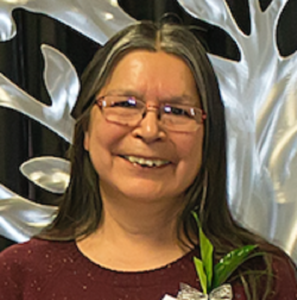Epiichiikmaang Nishnaabemin dictionary: A progress report

By Mary Ann Corbiere
I, like those who are aware that this project began years ago, thought it would be done by now. This report is to say that the work is ongoing, albeit haltingly. Rand Valentine (who’s working mainly on the computer aspect) and I are nearing the final stage. I began reviewing the information on the 5,000-plus terms still to be added to those in the 2015 Nishnaabemwin Online Dictionary back in June. I am correcting typos, making other necessary revisions, and double-checking some linguistic aspects with Rand. Going over the roughly 2,230 terms left to review (as of this writing) will take several more weeks. Rand and another specialist will then, with their computer know-how, put the information in the form needed to produce a print dictionary.
Proofreading for typos is only a small aspect of the review task. Many terms need clearer translations. Not all are as easily translatable, and good English wording doesn’t always come readily to me. We who Nishnaabem (speak in the Nishnaabe tongue) know meanings in that we know the context in which a word makes sense or see in our minds the image it evokes, but conveying images clearly in English is hard for many verbs. The English wording might not evoke the same kind of image in the minds of learners, the group we particularly want this dictionary to help. In striving to convey the mental images eNshinaabemjik have, the translations I come up with often sound quite odd. They don’t reflect normal English phrasing in which learners think when they go to express themselves in our language.
The principal challenge for us then is to lead learners to the terms that are natural to eNshinaabemjik. How we try to do so depends on the word. The nifty verb, zaagdweweshin, is one example. For this, I’ve given two wordings: “one’s footfalls be heard as person is going out of a house; sound of one’s voice travel out of a house.” English speakers might say simply, “I heard him going out of the house,” and “He can be heard outside the house.” They wouldn’t make explicit that it’s footfalls or a voice being heard whereas eNshinaabemjik naturally would. In this sort of situation — awkward or unclear translations — example sentences are important. They (we hope) help learners visualize the kind of situation in which the term concerned would naturally arise. Some sentences come from my dictionary workshop notes; workshop participants’ remarks often illustrated a word’s meaning really well. Others, I think of as I go along. English translations accompany the example sentences.
Some verbs apply to specific types of objects, so information like “stick-like object,” sheet-like, string-like, and so on, needs to be included in their translation. Some specify whether an action is done with the hand(s), or with an instrument, or with the force of one’s weight. “Damage sth. (an.)” is too general a translation for mzhinaa for instance; “by touching it” needs to be included. In reviewing this, I wonder if I should add a second wording, “damage sth. (an.) in handling it.” Questions like this usually have me mulling for some moments before deciding what to do, hence my halting pace in reviewing everything. There are many words for which the information is already complete and typo-free, and whose translation seems clear enough, but I also come across quite a few terms that having me mulling over possible revisions for a while. When I recall that I finished reviewing the first batch of 370 words a couple of months ago, I realize how the time on the overall task is adding up.
Finishing this aspect of the project won’t mean publication of a print dictionary will be imminent. Rand’s work on the computer aspects will also take some time — how much, we can’t predict. We can say only that we’re striving to get the 5,000-plus words into the online dictionary as soon as possible. As for a print dictionary, much as we’d like that to have all the information we’re compiling, doing so would make it cost prohibitive. So, determining which information to put into print form will be another one of our tasks. Because an opportunity for an eNshinaabemat to carry out such a comprehensive endeavour might not arise again, it is critical that this project document as much of our vocabulary as possible. The last formally published dictionary, Rhodes’s 1985 Ojibwa-Chippewa-Ottawa dictionary, does not have the 5,000-plus words I’m now checking. Waa-ni-Nishnaabemjik – those who will be speaking in the Nishnaabek’s tongue – need a more comprehensive resource to draw on to express themselves in their people’s language. All this is to say, please bear with us.
Miigwech. Nahaaw, back to reviewing.


